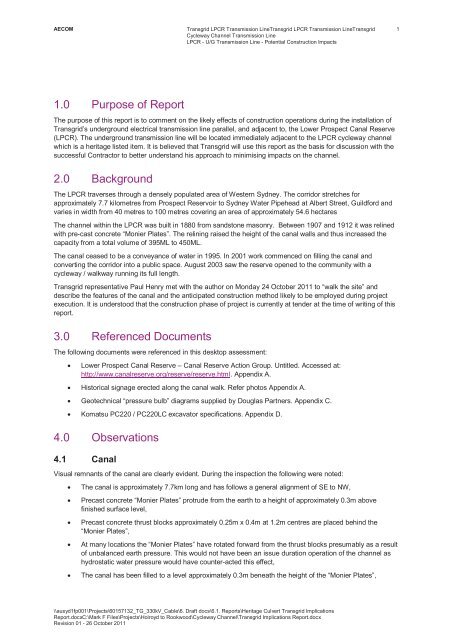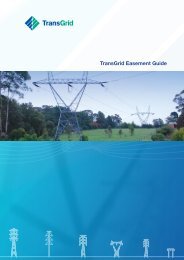Holroyd to Rookwood Road cable REF - TransGrid
Holroyd to Rookwood Road cable REF - TransGrid
Holroyd to Rookwood Road cable REF - TransGrid
You also want an ePaper? Increase the reach of your titles
YUMPU automatically turns print PDFs into web optimized ePapers that Google loves.
AECOM Transgrid LPCR Transmission LineTransgrid LPCR Transmission LineTransgrid<br />
Cycleway Channel Transmission Line<br />
LPCR - U/G Transmission Line - Potential Construction Impacts<br />
1.0 Purpose of Report<br />
The purpose of this report is <strong>to</strong> comment on the likely effects of construction operations during the installation of<br />
Transgrid’s underground electrical transmission line parallel, and adjacent <strong>to</strong>, the Lower Prospect Canal Reserve<br />
(LPCR). The underground transmission line will be located immediately adjacent <strong>to</strong> the LPCR cycleway channel<br />
which is a heritage listed item. It is believed that Transgrid will use this report as the basis for discussion with the<br />
successful Contrac<strong>to</strong>r <strong>to</strong> better understand his approach <strong>to</strong> minimising impacts on the channel.<br />
2.0 Background<br />
The LPCR traverses through a densely populated area of Western Sydney. The corridor stretches for<br />
approximately 7.7 kilometres from Prospect Reservoir <strong>to</strong> Sydney Water Pipehead at Albert Street, Guildford and<br />
varies in width from 40 metres <strong>to</strong> 100 metres covering an area of approximately 54.6 hectares<br />
The channel within the LPCR was built in 1880 from sands<strong>to</strong>ne masonry. Between 1907 and 1912 it was relined<br />
with pre-cast concrete “Monier Plates”. The relining raised the height of the canal walls and thus increased the<br />
capacity from a <strong>to</strong>tal volume of 395ML <strong>to</strong> 450ML.<br />
The canal ceased <strong>to</strong> be a conveyance of water in 1995. In 2001 work commenced on filling the canal and<br />
converting the corridor in<strong>to</strong> a public space. August 2003 saw the reserve opened <strong>to</strong> the community with a<br />
cycleway / walkway running its full length.<br />
Transgrid representative Paul Henry met with the author on Monday 24 Oc<strong>to</strong>ber 2011 <strong>to</strong> “walk the site” and<br />
describe the features of the canal and the anticipated construction method likely <strong>to</strong> be employed during project<br />
execution. It is unders<strong>to</strong>od that the construction phase of project is currently at tender at the time of writing of this<br />
report.<br />
3.0 Referenced Documents<br />
The following documents were referenced in this desk<strong>to</strong>p assessment:<br />
Lower Prospect Canal Reserve – Canal Reserve Action Group. Untitled. Accessed at:<br />
http://www.canalreserve.org/reserve/reserve.html. Appendix A.<br />
His<strong>to</strong>rical signage erected along the canal walk. Refer pho<strong>to</strong>s Appendix A.<br />
Geotechnical “pressure bulb” diagrams supplied by Douglas Partners. Appendix C.<br />
Komatsu PC220 / PC220LC excava<strong>to</strong>r specifications. Appendix D.<br />
4.0 Observations<br />
4.1 Canal<br />
Visual remnants of the canal are clearly evident. During the inspection the following were noted:<br />
The canal is approximately 7.7km long and has follows a general alignment of SE <strong>to</strong> NW,<br />
Precast concrete “Monier Plates” protrude from the earth <strong>to</strong> a height of approximately 0.3m above<br />
finished surface level,<br />
Precast concrete thrust blocks approximately 0.25m x 0.4m at 1.2m centres are placed behind the<br />
“Monier Plates”,<br />
At many locations the “Monier Plates” have rotated forward from the thrust blocks presumably as a result<br />
of unbalanced earth pressure. This would not have been an issue duration operation of the channel as<br />
hydrostatic water pressure would have counter-acted this effect,<br />
The canal has been filled <strong>to</strong> a level approximately 0.3m beneath the height of the “Monier Plates”,<br />
\\ausyd1fp001\Projects\60157132_TG_330kV_Cable\6. Draft docs\6.1. Reports\Heritage Culvert Transgrid Implications<br />
Report.docxC:\Mark F Files\Projects\<strong>Holroyd</strong> <strong>to</strong> <strong>Rookwood</strong>\Cycleway Channel\Transgrid Implications Report.docx<br />
Revision 01 - 26 Oc<strong>to</strong>ber 2011<br />
1




